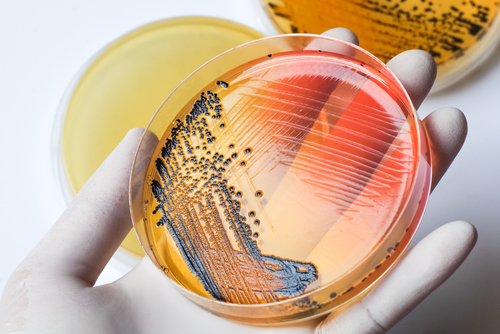Identifying Changes to P. aeruginosa in Lungs May Help With Treatment

Pseudomonas aeruginosa mutate into a mucoid form in the lungs of people with cystic fibrosis (CF), creating biofilms that render these bacteria more resistant and more damaging, a study reported.
Its researchers suggest a way of studying P. aeruginosa cells to identify treatments most likely to break down these biofilms and protect patients’ lungs.
The study, “Material properties of interfacial films of mucoid and nonmucoid Pseudomonas aeruginosa isolates,” was published in the journal Acta Biomaterialia.
CF patients are susceptible to infections from bacteria, viruses, and fungi, because a thick and viscous mucus accumulates in their lungs. Infection with P. aeruginosa can be particularly damaging, as these bacteria can also develop biofilms —communities of sticky bacteria strains that are resistant to standard antibiotic therapies, and more likely to be chronic infections.
A team of researchers at the Swanson School of Engineering, University of Pittsburgh investigated the properties of CF mucus and the role it plays in the ability of P. aeruginosa to survive. Specifically, they examined both P. aeruginosa‘s nonmucoid (PANT) and mucoid (PASL) strains.
P. aeruginosa adapts to its host environment by mutating from PANT to PASL. This mutation creates a protective film of mucus around these bacteria, forming a more hydrated and slimy biofilm in the mucus. It also shields P. aeruginosa from phagocytic cells, which help the immune system clear dead or harmful cells by ingesting them.
“Think of the cells like grains of rice. PANT cells are like basmati rice, while PASL cells are like sushi rice: coated in such a way that they stick together when they’re compressed,” Tagbo Niepa, PhD, assistant professor of chemical and petroleum engineering and the study’s senior author, said in a press release.
“We can measure how investigational drugs can alter the sticky nature of the coating that pathogens such as P. aeruginosa create upon mutation,” Niepa added.
The team reasoned that the surface properties of cells in the PASL (mucoid) strain of P. aeruginosa influence the mechanical behavior of their biofilms. To test this hypothesis, the researchers examined the surface properties of PANT and PASL bacterial films using pendant drop tensiometry — a technique that allows the surface and interfacial tension of fluids to be measured.
Results showed the dynamic interactions of live cells with fluid interfaces, as well as their surface properties, might contribute to the faster absorption of mucoid strains.
Two other techniques — scanning electron microscopy and scanning transmission electron microscopy, used to assess changes in cell morphology — allowed a detailed visualization of these two cell types. Major differences in the surface properties of PANT and PASL cells were found, suggesting that morphological differences may contribute to differences in their behavior.
Films of the nonmucoid strains also exhibited higher viscoelasticity at fluid surfaces than did mucoid strains due to their surface properties and secreted molecules. To further analyze these differences, the researchers investigated the dilational viscoelastic properties of PANT and PASL films using the oscillating pendant drop technique — a method for measuring dynamic surface and interface tension.
PANT films showed higher elastic properties, while the mucoid films behaved as a softer, or more viscous, material.
Stress relaxation experiments were then done to further investigate the effects of higher deformations on the mechanical integrity of bacterial films when subjected to larger compression and dilation.
Results showed that the material properties of the PANT films were conserved under both compression and tension. The mucoid films, in contrast, exhibited greater relaxation following a compressive strain than a tensile one.
Finally, researchers used pendant capsule elastometry — an image technique that analyzes the shape of deflated elastic material — to characterize film micromechanics.
The wrinkling and shape analyses of bacterial films showed that the mucoid strain exhibited remarkable viscoelastic properties, with higher bending and compression ability, enabling the remodeling of the living films and dissipation of the compressive stress.
“This is the first time that the pendant drop elastometry technique has been used to study the mechanics of these cells,” Niepa said.
This work “can be used to investigate the efficacy of mucolytic drugs — drugs that are used to break down the film of mucus that the cells are making,” Niepa added. “This technique could be powerful for investigating those agents, to see if they have the anticipated effect.”
The “mucoid switch [in P. aeruginosa] can play an important role in protecting the bacteria from interfacial stresses,” the researchers concluded.
“Further analyses of the micromechanics of mucoid films and their response to various physicochemical cues can provide new insights into the methods to control persistent P. aeruginosa infections associated with interfacial environments such as the lungs of CF patients,” they added.
“Such analyses may reveal details about the drag force required to remove biological materials from fluid interfaces.”
Among limitations to the study findings, the team reported, was the fact that the system two-dimensional, and as such could be inadequate to characterize three-dimensional biofilms.







